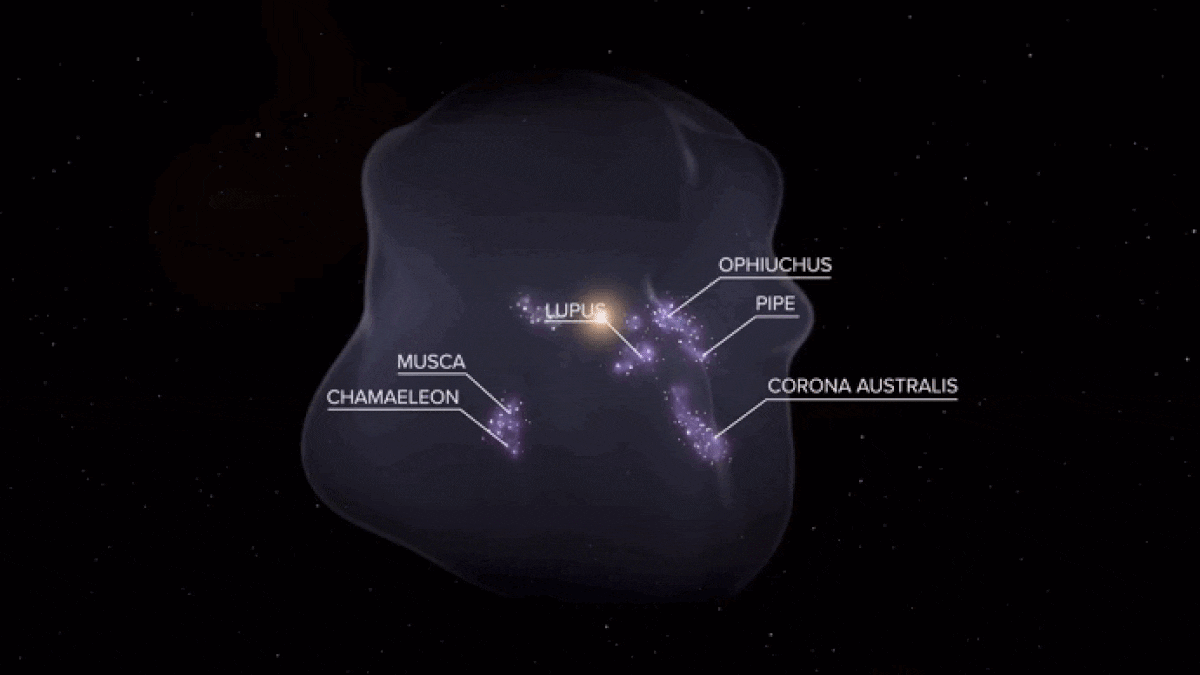14 million years ago, the Sun was about 900 light-years away from a star that exploded as a supernova.
The amount of energy associated with this explosion led to the formation of a bubble of hot gas in the interstellar medium.
At that time it was not us, strictly speaking, who were on the planet, but our relatives, the first great apes that were beginning to appear at that time.
Only 9 million years later, we humans were already separating from chimpanzees to become a distinct branch of bipeds, and the Sun and all the planets of the Solar System that it trails, we entered that bubble.
Because our star is moving at a different speed than its immediate surroundings, now, 5 million years after entering, we are in the center of the bubble, about 150 light-years from the edge in each direction.
And luckily we were (I mean orangutans) far away when the first of the 15 supernovae responsible for the formation of the bubble exploded.
This bubble, a kind of explosive and very hot soap bubble, is known as the Local Bubble and is like a bain-marie at a temperature of one million degrees in which the entire Solar System is immersed.
We don't know if it's closed or broken.
It could be what we know as a galactic vent, and it's busted on the outside, traversing a few hundred light-years above and below the plane of our galaxy.
We have known of its existence for years.
Its edges are expanding at about 7 kilometers per second, in the time you've been reading it has advanced 280 kilometers and could have flattened the equivalent of many of those beet fields that have suddenly become so fashionable.
It advances in an environment that has very different conditions: it gains ground on the "normal" interstellar medium where we find 1 atom every 10 cubic centimeters approximately at temperatures of 6,000-7,000 degrees.
In the bubble to find an atom we have to increase the volume to 1,000 cubic centimeters and, as it emits X-rays, it occurs to me that aliens could use it to look at our suitcases when leaving the Solar System.
The fact is that recently the data from the European satellite
Gaia
, which is giving us so much joy, have made it possible to make a three-dimensional map of the environment in which we live, revealing important clues about the effect of the Local Bubble and the energy it releases.
To make maps of our environment, Gaia has to measure the positions and speeds of stars and clouds of gas and dust and reconstruct their movement.
It's like having a fairground track full of bumper cars for which we can only take a “snapshot” of their speed and position from the center of the track.
But our stars can also move up and down, they can go off track and travel through vertical space.
With those instantaneous measurements we have to reconstruct exactly where they were when the horn sounded and everything started moving.
The problem is complicated.
But what it shows
Gaia
reconstructing the movement and position of the stars is revealing.
The geometry and movements observed indicate that all the regions where star formation is taking place within 650 light years of the Sun have done so as a consequence of the expansion of the Local Bubble.
Fascinating, especially because supernovae are like fictional characters and when they are well characterized they are gray characters: one does not know if they are good or bad, they depend on the circumstances they go through.
The debate, which has been going on for many years in the scientific literature, tries to decipher whether these explosions, one of the most energetic in the universe, destroy everything in their path or, on the contrary, are the seed that interstellar gas clouds need to start form stars.
Well, it seems that the local bubble, which has required the explosion of approximately 15 supernovae to form, has worked as a kind of piston.
The expansion compresses the gas triggering star formation at the edge of the bubble.
Supernova explosions form stars.
Point.
This is how we see it in those that are close thanks to Gaia and the team led by Catherine Zucker who published it recently.
Eva Villaver
is a researcher at the Center for Astrobiology, dependent on the Higher Council for Scientific Research and the National Institute for Aerospace Technology (CAB/CSIC-INTA).
Cosmic Void
is a section in which our knowledge about the universe is presented in a qualitative and quantitative way.
It is intended to explain the importance of understanding the cosmos not only from a scientific point of view but also from a philosophical, social and economic point of view.
The name "cosmic vacuum" refers to the fact that the universe is and is, for the most part, empty, with less than one atom per cubic meter, despite the fact that in our environment, paradoxically, there are quintillion atoms per meter cubic, which invites us to reflect on our existence and the presence of life in the universe.
The section is made up of
Pablo G. Pérez González
, researcher at the Center for Astrobiology;
Patricia Sanchez Blazquez
, full professor at the Complutense University of Madrid (UCM);
and
Eva Villaver
, researcher at the Center for Astrobiology.
You can follow
MATERIA
on
,
and
, or sign up here to receive
our weekly newsletter








